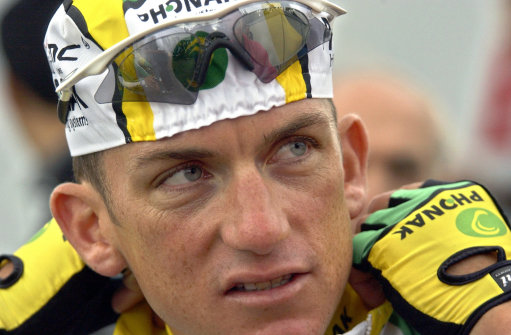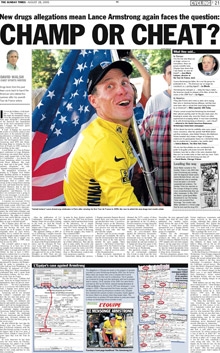Lance Armstrong: Edgar Allan Poe, The Troll’s revenge and what Betsy Andreu saw
 LANCE Armstrong is likely to feature a lot in the Times. The seven-times Tour de France winner has decided not to contest doping charges against him. The man who got rich on the back of those successes will not fight for his integrity. Armstrong has been stripped of those Tour titles and every every other result he had achieved since 1998.
LANCE Armstrong is likely to feature a lot in the Times. The seven-times Tour de France winner has decided not to contest doping charges against him. The man who got rich on the back of those successes will not fight for his integrity. Armstrong has been stripped of those Tour titles and every every other result he had achieved since 1998.
In 1999, the Sunday Times went for Armstrong. David Walsh wrote:
“For too long, sportswriting has been unrestrained cheerleading, suspending legitimate doubts and settling for stories of sporting heroism.”
In 2001, Walsh told Sunday Times readers that Armstrong had worked with Italian doctor Michele Ferrari. The story was called Champ of Cheat? The paper had a question: “why would a clean rider work with a dirty doctor?”
On Ferrari, who worked with Armstrong on his six of those seven triumphs:
On October 1, 2004, Ferrari was convicted of sporting fraud and abusive exercise of the profession of pharmacist and sentenced by Judge Maurizio Passarini.
On May 27, 2006 the Italian Court of Appeal in Bologna absolved Dr. Michele Ferrari of all charges.
The U.S. Anti-Doping Agency alleges “Ferrari developed a mixture of testosterone and olive oil that could avoid detection and helped riders take banned blood boosters. Ferrari calls the oil-steroid mixture an old ‘legend’ in cycling.”
A further Sunday Times story entitled LA Confidential was published in June 2004. Armstrong sued. He won. In July 2006, the High Court ruled that the meaning of the article was that Armstrong was a “fraud, a cheat and a liar”. The paper apologised.
And waited.
On September 2, 2012, the Sunday Times wrote below the headline “Armstrong ‘had drugs courier’”:
Lance Armstrong is facing fresh allegations that he cheated in his first Tour de France victory in 1999 with the help of a motorcyclist who rode behind the competitors with a vacuum flask full of EPO, the performance-enhancing drug.
Tyler Hamilton [pictured], an American cyclist who rode with Armstrong on the US Postal Service team, claims the motorcyclist dispensed the EPO to riders after race stages. Drugs were also handed out to the team in white lunch bags.
The allegations emerge eight years after The Sunday Times published an article that raised questions over whether Armstrong had cheated with drugs. Armstrong took advantage of Britain’s stringent libel laws and the newspaper was eventually forced to settle the case.
Armstrong was last month stripped of his seven Tour de France titles after announcing he would not contest doping charges by the US Anti-Doping Agency. The Sunday Times is now reviewing the terms of its libel settlement with Armstrong, which cost £600,000 in legal bills and contributions to the cyclist’s own legal costs.
This is what the newspapers still do best.
 David Walsh had his own professional reputation sullied by the settlement. In August, he wrote for the Sunday Times:
David Walsh had his own professional reputation sullied by the settlement. In August, he wrote for the Sunday Times:
…Betsy Andreu was tipped off about the news earlier that day by a friend closely connected to the investigation. Of all those who believed Armstrong to be a drug cheat, she was one of the most convinced and, without doubt, the most courageous.
Her husband Frankie had ridden for eight years on the US Postal team that Armstrong led and for a long time they were the closest of friends. Everything changed when she and Frankie visited Armstrong at Indiana University hospital in late October 1996 when he was fighting cancer. “We heard Lance tell doctors he had used performance-enhancing drugs before his cancer,” she says.
Three years later Armstrong won his first Tour de France. Watching the television coverage at her Dearborn home, Andreu heard her husband praised for the work he did in setting the tempo in the early part of the climb to the Italian ski resort of Sestriere.
She, however, was convinced that her husband could not have ridden that strongly in the mountains without performance-enhancing drugs — and confronted him when she travelled to France for the final week of the race.
After an initial denial, he admitted he had, indeed, doped to help Armstrong but agreed not to do so again. At the end of the following year, there was no place for Frankie Andreu on the US Postal team.
Andreu refers to Walsh as “The Troll”. Walsh quotes her:
“I felt strangely anti-climactic,” she said. “I wanted him [Armstrong] to fight the charges before an independent panel. I would have liked the opportunity to prove the truth of what I heard in that hospital room 16 years ago.”
Adding:
“What’s the upside been going up against Lance? To be publicly portrayed as an ugly, obese, jealous, obsessed, hateful, crazed bitch.”
Walsh then nail Armstrong with two quotes.
* Explaining his refusal to have his case adjudicated by an independent panel, Armstrong hinted at a sense of resignation. “There comes a point in every man’s life when he has to say, ‘Enough is enough.’ For me, that time is now.”…
* When I first interviewed Armstrong in 1993, two days into his first Tour de France, he was 21 and spoke passionately about the role his single mother, Linda, had played in his life. “She taught that if you give up, you give in,” he said. “I never give up.”
Armstrong denies any wrongdoing. But people are lining up to damn him. In today’s Times, the lead story is about Armstrong.
The Lance Armstrong myth is further shattered today by a former team-mate’s account of the cyclist’s long history of doping. The Times carries the first exclusive extract of Tyler Hamilton’s explosive book, in which he portrays Armstrong as a man who used drugs and duplicity to cheat his way to victory in the Tour de France.
Great time to plug your book. The superstar is on his knees. The book will slay him.
The Secret Race: Inside the Hidden World of the Tour de France: Doping, Cover-ups and Winning at All Costs, published today in the United States, alleges doping on a shocking scale at US Postal Service, for whom they raced together, and Armstrong’s certainty that he could outwit the authorities.
Hamilton depicts a man “haunted” by the thought rivals might be one step ahead, talking of “Lance’s Golden Rule: whatever you do, those other f***ers are doing more”, which he claims made Armstrong train harder and also chase the most effective doping with Michele Ferrari, his trusted doctor.
The drugs?
In the book, Hamilton describes how he was first given “red eggs” of testosterone before moving on to EPO and then, in 2000, flying to Spain with Armstrong in a private jet to give blood that would be injected back into his system during the Tour. Hamilton left US Postal and went on to work with Eufemiano Fuentes, a Spanish doctor who helped many leading cyclists with transfusions and supplied them with cocktails of drugs.
How were the drugs administered?
For the Tour de France in 1999, US Postal hired Armstrong’s gardener, nicknamed Motoman, to follow the Tour on a motorbike, carrying a Thermos flask full of EPO vials and a prepaid cell phone. “When we needed ‘Edgar [Allan Poe, the nickname for EPO]’, Phillipe would zip through the Tour’s traffic and make a drop-off.” Used syringes were put into a Coke can which was crushed and given to the team doctor, who carried it away in his knapsack unnoticed through the crowds.
Hamilton writes:
Hey dude, you got any Poe I can borrow?
Lance pointed casually to the fridge.
I opened it and there, on the door, next to a carton of milk, was a carton of EPO, each stoppered vial standing upright, little soldiers in their cardboard cells. I was surprised that Lance would be so cavalier. On the occasions I had kept EPO in my Girona fridge, I had taken it out of its cardboard packaging, wrapped it in foil, and put it in the back, out of sight.
But Lance seemed relaxed about it. I figured he knew what he was doing. I took a vial, and thanked him.
And on it goes.
Bill Strickland has a question: what happens to Armstong’s yellow jerseys?
If a guilty verdict were taken to its most logical endpoint, Armstrong would be stripped of all seven of the yellow jerseys that are the iconic proof of victory in the Tour de France, that emanate a cultural resonance so powerful and pervasive, and so emblematic of what he had accomplished (and perhaps even of who he was) that he appropriated the color in the branding of himself and his cancer awareness charity, Livestrong. Without those jerseys, he could not have become the world’s most visible advocate in the fight against cancer, nor would he ever have hung out with Matthew McConaughey or made out with Ashley Olsen—or, arguably, become a target of USADA. (None of the non-Tour-winning American teammates who doped with him were ever named as prime subjects of an investigation in the absence of a positive test for banned substances.)
What would happen to the jerseys would be an absurdity.
Probably the most notable outcome is that Jan Ullrich becomes a unique champion, a four-time winner of the Tour, more decorated than Greg LeMond. Ullrich is, of course, an admitted and convicted doper. The farce on top of this farce would be the continued possession of a yellow jersey by Bjarne Riis. After the 1996 Tour winner admitted in 2007 that he’d used EPO to achieve his victory, the race organizers told him not to attend that year’s edition, and in the official listing of winners in the online archive and elsewhere, a blank space appeared where his name once was. The next year, he was back at the Tour as a directeur sportif, and his name was back on the list.
And on it goes…
Posted: 5th, September 2012 | In: Key Posts, Sports Comment | TrackBack | Permalink


